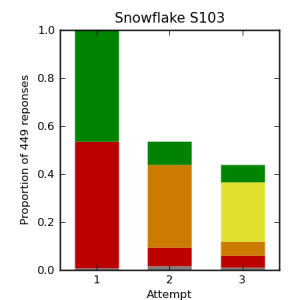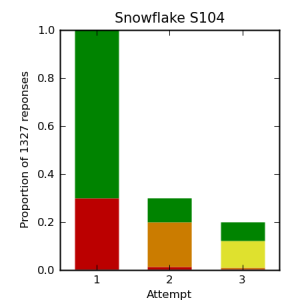 The figure shown on the left requires a bit of explaining. The three columns represent student responses at 1st, 2nd and 3rd attempt to a short-answer free-text question in formative use. Green represents correct responses; red/orange/yellow respresent incorrect responses. The reason I’ve used different colours here is to enable me to indicate repeated responses. Where a colour is identical from column to column, this means that an incorrect response from a first or second response was repeated exactly at second and/or third attempt. The colour grey represents responses that were completely blank. The figure shows that
The figure shown on the left requires a bit of explaining. The three columns represent student responses at 1st, 2nd and 3rd attempt to a short-answer free-text question in formative use. Green represents correct responses; red/orange/yellow respresent incorrect responses. The reason I’ve used different colours here is to enable me to indicate repeated responses. Where a colour is identical from column to column, this means that an incorrect response from a first or second response was repeated exactly at second and/or third attempt. The colour grey represents responses that were completely blank. The figure shows that
- at first attempt, four responses (0.9% of the total of 449) were blank;
- at second attempt, 43 responses (17.8% of the total of 241) were identical with responses given at the first attempt, with 7 responses (2.9%) blank;
- at third attempt, 54 responses (27.4% of the total of 197) were identical with responses given at the second attempt, with 3 responses (1.5%) blank.
Reasons given by students (in interviews) for leaving the response box blank and repeating responses include just wanting to get to the final worked-example, not understanding the question and not understanding the feedback.
 The figure on the right is for exactly the same question, but in low-stakes summative use. Not surprisingly, the proportion of repeated and blank responses is smaller. Now
The figure on the right is for exactly the same question, but in low-stakes summative use. Not surprisingly, the proportion of repeated and blank responses is smaller. Now
In summative use, students are only likely to leave a response blank or repeat a response if they have absolutely no idea how to proceed i.e. if they don’t understand the question or the feedback provided. There’s a lesson for us there. I think there is also a lesson in the deeper engagement illustrated in summative use.

Pingback: e-assessment (f)or learning » Blog Archive » More about guessing and blank/repeated responses